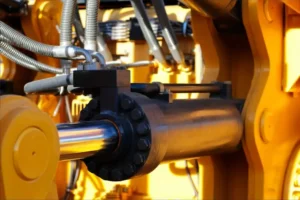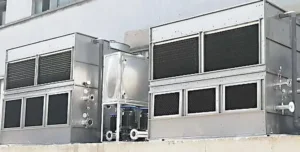เบ้าหลอมเตาแบบเหนี่ยวนำเป็นอุปกรณ์อุตสาหกรรมพิเศษที่ใช้สำหรับการทำความร้อนแบบเหนี่ยวนำ, มักใช้ในการให้ความร้อนโลหะและวัสดุนำไฟฟ้าอื่น ๆ. การเหนี่ยวนำเบ้าหลอมใช้หลักการของการทำความร้อนเหนี่ยวนำและใช้กระแสวนที่เกิดจากการเหนี่ยวนำแม่เหล็กไฟฟ้าเพื่อให้ความร้อนวัสดุ. อุปกรณ์นี้ส่วนใหญ่ประกอบด้วยส่วนต่อไปนี้:
- เบ้าหลอม: เบ้าหลอมมักจะเป็นภาชนะที่เก็บวัสดุให้ร้อน. มันมักจะทำจากวัสดุที่เป็นสื่อกระแสไฟฟ้า, เช่นเบ้าหลอมโลหะ. ในการเหนี่ยวนำเบ้าหลอม, ด้านล่างของเบ้าหลอมเป็นส่วนหนึ่งของขดลวดเหนี่ยวนำ, ซึ่งเป็นส่วนสำคัญของการทำความร้อน.
- ขดลวดเหนี่ยวนำ: ขดลวดเหนี่ยวนำของเบ้าหลอมเหนี่ยวนำเป็นบาดแผลของคอยล์นำไฟฟ้าเข้าไปในดิสก์หรือรูปทรงเกลียว, มักจะทำจากทองแดงหรือวัสดุนำไฟฟ้าที่ยอดเยี่ยมอื่น ๆ. เมื่อกระแสไฟฟ้ากระแสสลับผ่านขดลวดเหนี่ยวนำ, มันสร้างสนามแม่เหล็กไฟฟ้าที่เปลี่ยนแปลง.
- แหล่งพลังงาน RF: เบ้าหลอมเหนี่ยวนำจำเป็นต้องเชื่อมต่อกับความถี่วิทยุ (RF) แหล่งพลังงาน. แหล่งพลังงานนี้ให้กระแส AC ที่มีความถี่สูง, โดยปกติจะอยู่ในช่วงหลายสิบกิโลเฮิร์ตซ์ถึงหลายเมกะเฮิร์ตซ์. กระแสไฟฟ้าความถี่สูงนี้ผ่านขดลวดเหนี่ยวนำ, สร้างกระแสวนที่ทำให้ความร้อนด้านล่างของเบ้าหลอมร้อน.

หลักการทำงานของเบ้าหลอมเหนี่ยวนำขึ้นอยู่กับกฎการเหนี่ยวนำแม่เหล็กไฟฟ้าของฟาราเดย์. เมื่อกระแสไฟฟ้าความถี่สูงผ่านขดลวดเหนี่ยวนำ, สนามแม่เหล็กที่เปลี่ยนไปสร้างกระแสไหลวนภายในเบ้าหลอม. กระแสวนเหล่านี้ทำให้เกิดการทำความร้อนในวัสดุ, ทำให้วัสดุเพิ่มอุณหภูมิ. ข้อได้เปรียบหลักของไม้กางเขนเหนี่ยวนำคือความสามารถในการทำความร้อนแบบไม่มีสัมผัส, ทำให้เหมาะสำหรับการใช้งานที่ต้องการการควบคุมอุณหภูมิที่แม่นยำและความร้อนอุณหภูมิสูง, เช่นกระบวนการอุตสาหกรรมเช่นการถลุงโลหะ, การเผา, และดับ. การเหนี่ยวนำไม้กางเขนมักใช้ในการวิจัยในห้องปฏิบัติการและการวิเคราะห์วัสดุเพื่อให้การควบคุมความร้อนและการระบายความร้อนที่แม่นยำ.
มีร่องรอยกี่ชนิด?
- เบ้าหลอมเซรามิก: เบ้าหลอมเซรามิกมักทำจากวัสดุเซรามิก, เช่นอลูมินา, ควอตซ์, อมตะ, ฯลฯ. พวกเขามีความต้านทานอุณหภูมิสูงและเฉื่อยทางเคมี, ทำให้เหมาะสำหรับการหลอมละลาย, การเผา, และการวิเคราะห์ตัวอย่างที่อุณหภูมิสูง.
- เบ้าหลอมโลหะ: เบ้าหลอมโลหะมักจะทำจากวัสดุโลหะ, เช่นแพลตตินัม, นิกเกิล, สแตนเลส, ฯลฯ. พวกเขาใช้สำหรับการถลุงโลหะ, การทดสอบดับและอุณหภูมิสูงที่อุณหภูมิสูงและมีค่าการนำความร้อนที่ดี.
- เบ้าหลอมควอตซ์: เบ้าหลอมควอตซ์มักจะใช้สำหรับการทดลองวิเคราะห์ความร้อนที่อุณหภูมิสูง, เช่นแคลอรี่สแกนที่แตกต่างกัน (DSC) และการวิเคราะห์ Thermogravimetric (TGA). พวกมันเฉื่อยต่อสารเคมีจำนวนมากและเหมาะสำหรับการวิจัยที่อุณหภูมิสูง.
- เบ้าหลอมแก้ว: เบ้าหลอมแก้วมักจะใช้สำหรับการทดลองครั้งเดียวหรือแอปพลิเคชันอุณหภูมิที่ต่ำกว่า. โดยทั่วไปจะไม่เหมาะสำหรับอุณหภูมิสูงหรือกรดที่แข็งแรงและเงื่อนไขอัลคาไล.
- ไม้กางเขนบด: ไม้กางเขนเหล่านี้มักได้รับการออกแบบมาเป็นพิเศษเพื่อบดตัวอย่างเป็นรูปแบบผง. มักใช้สำหรับการเตรียมตัวอย่างและการวิเคราะห์อนุภาค.
- โครไนเบิลคอลเลกชัน: ไม้กางเขนเหล่านี้ได้รับการออกแบบมาเพื่อรวบรวมตัวอย่างก๊าซในการทดลอง, โดยทั่วไปสำหรับวิธีการวิเคราะห์เช่นแก๊สโครมาโตกราฟี.
- เบ้าหลอมถ้วยลึก: เบ้าหลอมถ้วยลึกมีรูปร่างถ้วยที่ลึกและแคบและเหมาะสำหรับการวัดตัวอย่างของเหลว, เช่นการกำหนดความสามารถในการละลายและการวิจัยอุณหพลศาสตร์โซลูชัน.
- เบ้าหลอมอลูมิเนียม: อลูมิเนียมเบ้าหลอมมักจะใช้สำหรับการวิเคราะห์การเผาไหม้ตัวอย่าง, เช่นการกำหนดปริมาณเถ้า.
การออกแบบและการผลิตเบ้าหลอม
คุณสมบัติการออกแบบและรูปร่าง:
- รูปร่าง: รูปร่างของเบ้าหลอมเตาเหนี่ยวนำมักจะเป็นทรงกระบอกที่มีด้านล่างแบนเพื่อให้แน่ใจว่าตำแหน่งที่เสถียรในขดลวดเหนี่ยวนำ. รูปร่างนี้ช่วยกระจายสนามแม่เหล็กไฟฟ้าของความร้อนเหนี่ยวนำให้เท่าเทียมกัน.
- ขนาด: ขนาดของเบ้าหลอมจะแตกต่างกันไปขึ้นอยู่กับขนาดของเตาเหนี่ยวนำและแอปพลิเคชันเฉพาะ. เตาหลอมขนาดเล็กอาจใช้ไม้กางเขนเส้นผ่านศูนย์กลางขนาดเล็ก, ในขณะที่เตาหลอมเหนี่ยวนำขนาดใหญ่ต้องการความสามารถในการเบ้าหลอมขนาดใหญ่เพื่อรองรับวัสดุงานมากขึ้น.
- ความหนาของผนัง: ความหนาของผนังของเบ้าหลอมมักจะถูกกำหนดตามประเภทของวัสดุที่ถูกประมวลผลและความต้องการอุณหภูมิ. กระบวนการอุณหภูมิสูงมักจะต้องใช้ผนังหนาเพื่อต้านทานความเครียดจากความร้อน.
โครงสร้าง:
- การเลือกวัสดุ: การเหนี่ยวนำของเตาเผามักทำจากวัสดุทนไฟอุณหภูมิสูง. วัสดุทั่วไปรวมถึงกราไฟท์, เซรามิกและควอตซ์. แต่ละวัสดุมีข้อดีและพื้นที่แอปพลิเคชันที่เป็นเอกลักษณ์ของตัวเอง.
- การเคลือบ: บางครั้งการตกแต่งภายในของเบ้าหลอมอาจถูกเคลือบด้วยการเคลือบป้องกันเพื่อปรับปรุงความต้านทานการกัดกร่อนและลดปฏิสัมพันธ์ระหว่างวัสดุและผนังเบ้าหลอม.
- การออกแบบด้านล่าง: ด้านล่างของเบ้าหลอมมักจะแบนเพื่อให้แน่ใจว่าการนำความร้อนสม่ำเสมอและการจัดวางที่ง่ายในขดลวดเหนี่ยวนำ. ด้านล่างอาจได้รับการออกแบบมาเป็นพิเศษเพื่อรองรับขดลวดเหนี่ยวนำพื้นเตาเผา.
กระบวนการผลิต:
กระบวนการผลิตเบ้าหลอมเกี่ยวข้องกับขั้นตอนต่อไปนี้:
- การเตรียมวัสดุ: เลือกวัสดุเบ้าหลอมที่เหมาะสม, มักจะเป็นวัสดุที่มีความเสถียรอุณหภูมิสูงเช่นกราไฟท์. วัสดุควรมีค่าการนำความร้อนที่จำเป็นและความแข็งแรงเชิงกลที่จำเป็น.
- การปรับแต่ง: การสร้างวัสดุให้เป็นรูปร่างที่ต้องการของเบ้าหลอม, มักจะเป็นรูปทรงกระบอก. สามารถทำได้โดยการอัดขึ้นรูป, การคัดเลือกนักแสดง, หรือกระบวนการขึ้นรูปอื่น ๆ.
- การเผาและการประมวลผล: วัสดุเช่นกราไฟท์มักจะต้องมีการเผาเพื่อปรับปรุงเสถียรภาพทางความร้อนของพวกเขา. ตรึงกางเขนเซรามิกอาจต้องใช้การเผาอุณหภูมิสูงเพื่อให้ได้โครงสร้างและคุณสมบัติที่ต้องการ.
- การเคลือบ: หากต้องการ, ใช้การเคลือบผิวด้านในของเบ้าหลอมเพื่อเพิ่มความต้านทานการกัดกร่อน.
- การทดสอบและการควบคุมคุณภาพ: ทำการทดสอบคุณภาพของไม้กางเขนเพื่อให้แน่ใจว่าตรงตามข้อกำหนดและข้อกำหนดด้านประสิทธิภาพ.
- การจัดส่งและการติดตั้ง: เบ้าหลอมที่ผลิตจะถูกส่งไปยังผู้ผลิตเตาหลอมหรือผู้ใช้ปลายทางจากนั้นติดตั้งลงในเตาเหนี่ยวนำ.
คุณสมบัติทางความร้อนของเบ้าหลอม
1. การนำความร้อน:
-คำนิยาม: การนำความร้อนเป็นความสามารถของวัสดุในการดำเนินการความร้อน. วัสดุที่มีค่าการนำความร้อนสูงสามารถถ่ายโอนความร้อนจากขดลวดเหนี่ยวนำไปยังวัสดุการทำงานได้อย่างมีประสิทธิภาพมากขึ้น.
-ความสำคัญ: ในเตาหลอมเหนี่ยวนำ, วัสดุงานจะต้องให้ความร้อนอย่างสม่ำเสมอ. ไม้กางเขนที่มีค่าการนำความร้อนที่ดีสามารถกระจายความร้อนได้อย่างสม่ำเสมอ, ตรวจสอบให้แน่ใจว่าวัสดุมีความร้อนเท่า ๆ กัน, จึงช่วยลดความเครียดจากความร้อนและปรับปรุงคุณภาพของวัสดุงาน.
2. ความต้านทานอุณหภูมิสูง:
-คำนิยาม: ความต้านทานอุณหภูมิสูงคือความสามารถของวัสดุในการรักษาความสมบูรณ์ของโครงสร้างและประสิทธิภาพภายใต้สภาวะอุณหภูมิสูง.
-ความสำคัญ: โดยทั่วไปแล้วเตาหลอมเหนี่ยวนำมักใช้ในการใช้งานที่อุณหภูมิสูงซึ่งอุณหภูมิสามารถเข้าถึงได้หลายพันองศาเซลเซียส. เบ้าหลอมจะต้องทนต่ออุณหภูมิสูงเพื่อให้แน่ใจว่าวัสดุไม่ละลาย, นิ่มนวล, หรือรอยแตก, ดังนั้นการรักษาความมั่นคงของกระบวนการทำงาน.
3. ความเสถียรทางเคมี:
– คำนิยาม: ความเสถียรทางเคมีคือความสามารถของวัสดุที่จะไม่ได้รับปฏิกิริยาทางเคมีที่ไม่พึงประสงค์เมื่อสัมผัสกับวัสดุงานที่ถูกประมวลผล.
-ความสำคัญ: ไม้กางเขนมักใช้ในการประมวลผลวัสดุที่มีองค์ประกอบทางเคมีต่างๆ, รวมถึงโลหะ, อัลลอยด์, และสารเคมี. ความเสถียรทางเคมีเป็นปัจจัยสำคัญในการรับรองว่าเบ้าหลอมไม่ได้ตอบสนองอย่างไม่น่าเชื่อกับวัสดุงาน, การป้องกันการปนเปื้อนของวัสดุหรือการกัดกร่อนของไม้กางเขนเซรามิก.
คุณสมบัติทางความร้อนเหล่านี้มีความสำคัญต่อการทำงานของเตาหลอมเหนี่ยวนำและกระบวนการจัดการวัสดุ. หากค่าการนำความร้อนของเบ้าหลอมเป็นไม่ดี, อาจทำให้วัสดุทำความร้อนไม่สม่ำเสมอและเพิ่มความเครียดจากความร้อน, จึงส่งผลต่อคุณภาพของวัสดุงาน. ไม้กางเขนที่มีความต้านทานอุณหภูมิต่ำอาจสูญเสียความเสถียรที่อุณหภูมิสูง, นำไปสู่ความผิดปกติและการปิดเครื่อง. ในเวลาเดียวกัน, ความไม่แน่นอนทางเคมีอาจทำให้เกิดการปนเปื้อนของวัสดุที่ไม่จำเป็นและลดคุณภาพของผลิตภัณฑ์.
ดังนั้น, การเลือกวัสดุเบ้าหลอมที่มีค่าการนำความร้อนที่ดี, ทนต่ออุณหภูมิสูง, และความเสถียรทางเคมี, เช่นเดียวกับการออกแบบเบ้าหลอมที่ถูกต้อง, มีความสำคัญมากสำหรับประสิทธิภาพของเตาหลอมเหนี่ยวนำและความสำเร็จของการประมวลผลวัสดุ.

การเหนี่ยวนำไม้กางเขนเป็นเครื่องมือที่ขาดไม่ได้ในด้านวิทยาศาสตร์เสมอ, อุตสาหกรรม, และห้องปฏิบัติการ. หลักการทำความร้อนที่เป็นเอกลักษณ์, คุณสมบัติวัสดุที่เหนือกว่า, และแอปพลิเคชันที่หลากหลายทำให้เป็นปัจจัยสำคัญในการทดลองและประสิทธิภาพในการทดลอง. เราได้พิจารณาเชิงลึกว่าการทำงานของ Crucibles Induction, การเลือกวัสดุ, กระบวนการผลิต, และวิธีใช้พวกเขา.
ความต้านทานอุณหภูมิสูง, ความเฉื่อยทางเคมี, และค่าการนำความร้อนของเบ้าหลอมเหนี่ยวนำทำให้มันมีบทบาทที่ไม่สามารถถูกแทนที่ได้ในสาขาการถลุงโลหะ, การเผา, การวิเคราะห์ความร้อน, และการวิจัยวัสดุ. ให้นักวิทยาศาสตร์, วิศวกร, และนักวิจัยที่มีเครื่องมือที่ทรงพลังในการแก้ปัญหาที่ซับซ้อน, ดำเนินการทดลองที่แม่นยำ, และผลักดันนวัตกรรม.
ในอนาคต, ฟิลด์ของการเหนี่ยวนำไม้กางเขนจะยังคงพัฒนาต่อไป. นวัตกรรมทางเทคโนโลยีและวัสดุใหม่จะช่วยปรับปรุงประสิทธิภาพของไม้กางเขนเหนี่ยวนำ, ขยายพื้นที่แอปพลิเคชันของพวกเขา, และผลักดันเขตแดนของกระบวนการทดลองและอุตสาหกรรม.
ไม่ว่าคุณจะทำการวิจัยในห้องปฏิบัติการหรือค้นหาโซลูชั่นอุณหภูมิสูงในการผลิตอุตสาหกรรม, การเหนี่ยวนำไม้กางเขนจะยังคงมีบทบาทสำคัญในการพัฒนาสาขาที่แตกต่างกัน. เราขอแนะนำให้คุณได้รับความเข้าใจที่ลึกซึ้งยิ่งขึ้นเกี่ยวกับศักยภาพของการเหนี่ยวนำไม้กางเขนและเลือกประเภทเฉพาะที่เหมาะสมกับความต้องการของคุณ, ช่วยให้การทดลองที่แม่นยำยิ่งขึ้นและการผลิตอุตสาหกรรมที่มีประสิทธิภาพมากขึ้น.
การเหนี่ยวนำเบ้าหลอมเป็นเครื่องมือสำคัญในระดับแนวหน้าของวิทยาศาสตร์และแรงผลักดันสำหรับความสำเร็จในการทดลองและนวัตกรรม. เราหวังว่าจะบรรลุเป้าหมายสำคัญมากขึ้นในการพัฒนาและสนับสนุนความสำเร็จที่น่าตื่นเต้นมากขึ้นในด้านวิทยาศาสตร์และวิศวกรรมในอนาคต.








